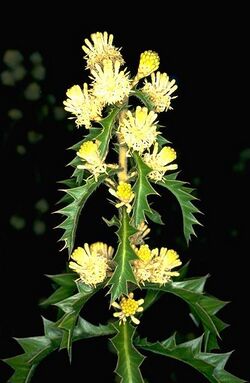Biology:Petrophile carduacea
| Petrophile carduacea | |
|---|---|

| |
| Scientific classification | |
| Kingdom: | Plantae |
| Clade: | Tracheophytes |
| Clade: | Angiosperms |
| Clade: | Eudicots |
| Order: | Proteales |
| Family: | Proteaceae |
| Genus: | Petrophile |
| Species: | P. carduacea
|
| Binomial name | |
| Petrophile carduacea Meisn.[1]
| |
| Synonyms[1] | |
|
Petrophila carduacea Meisn. orth. var. | |
Petrophile carduacea is a species of flowering plant in the family Proteaceae and is endemic to southwestern Western Australia. It is a shrub with deeply toothed leaves, and more or less spherical heads of hairy yellow flowers.
Description
Petrophile carduacea is a shrub that typically grows to a height of 1–2 m (3 ft 3 in–6 ft 7 in) and has hairy young branchlets. The leaves are 50–120 mm (2.0–4.7 in) long, 10–50 mm (0.39–1.97 in) wide and deeply toothed, the teeth broadly triangular and sharply-pointed. The flowers are arranged in leaf axils in more or less spherical heads about 10 mm (0.39 in) in diameter, with a few triangular involucral bracts at the base. The flowers are about 8 mm (0.31 in) long, yellow and hairy. Flowering occurs from September to October and the fruit is a nut, fused with others in an oblong head 20–35 mm (0.79–1.38 in) long on a peduncle up to 10 mm (0.39 in) long.[2][3]
Taxonomy
Petrophile carduacea was first formally described in 1856 by Carl Meissner in de Candolle's Prodromus Systematis Naturalis Regni Vegetabilis from material collected by James Drummond.[4][5] The specific epithet (carduacea) means "thistle-like".[6]
Distribution and habitat
This petrophile grows in scrub and heath in and near the Stirling Range in the Esperance Plains and Jarrah Forest biogeographic regions of southwestern Western Australia.[2][3]
Conservation status
Petrophile carduacea is classified as "Priority Two" by the Western Australian Government Department of Parks and Wildlife[3] meaning that it is poorly known and from only one or a few locations.[7]
References
- ↑ 1.0 1.1 "Petrophile carduacea". Australian Plant Census. https://biodiversity.org.au/nsl/services/apc-format/display/59475.
- ↑ 2.0 2.1 Foreman, David B.. "Petrophile carduacea". Australian Biological Resources Study, Department of Agriculture, Water and the Environment: Canberra. https://profiles.ala.org.au/opus/foa/profile/Petrophile%20carduacea.
- ↑ 3.0 3.1 3.2 "Petrophile carduacea". FloraBase. Western Australian Government Department of Parks and Wildlife. https://florabase.dpaw.wa.gov.au/browse/profile/2287.
- ↑ "Petrophile carduacea". APNI. https://id.biodiversity.org.au/instance/apni/463886.
- ↑ Meissner, Carl; de Candolle, Augustin P. (ed.) (1856). Prodromus systematis naturalis regni vegetabilis. 14. Paris: Sumptibus Sociorum Treuttel et Würtz. p. 274. https://www.biodiversitylibrary.org/item/109211#page/280/mode/1up. Retrieved 6 December 2020.
- ↑ Sharr, Francis Aubi; George, Alex (2019). Western Australian Plant Names and Their Meanings (3rd ed.). Kardinya, WA: Four Gables Press. p. 158. ISBN 9780958034180.
- ↑ "Conservation codes for Western Australian Flora and Fauna". Government of Western Australia Department of Parks and Wildlife. https://www.dpaw.wa.gov.au/images/documents/plants-animals/threatened-species/Listings/Conservation%20code%20definitions.pdf.
Wikidata ☰ Q18083636 entry
 |


